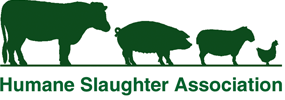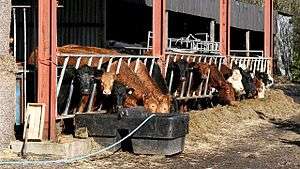Humane Slaughter Association
 | |
| Abbreviation | HSA |
|---|---|
| Motto | "Caring beyond the farm gate" |
| Founded | 1911[1] |
| Type | Charitable incorporated organisation |
| Registration no. | 1159690[2] |
| Focus | Humane livestock slaughter |
| Location |
|
Area served | United Kingdom and worldwide |
| Method | Research and training |
Key people | Dr. Robert C. Hubrecht (Chief Executive & Scientific Director)[4] |
Revenue | £316,723 (2012-13)[5] |
| Disbursements | £269,409 (2012-13)[5] |
| Endowment | £3,910,078 (2012-13)[5] |
Employees | 9[4] |
| Website |
www |
The Humane Slaughter Association (HSA) supports research, training, and development to improve the welfare of livestock during transport and slaughter. It provides technical information about handling and slaughter on its website, training for farmer staff and vets, advice to governments and industry, and funding of science and technology to make slaughter more humane.[6] HSA is the sister charity to Universities Federation for Animal Welfare.[7]
History
In 1911, the Council of Justice to Animals (CJA) was created to improve the slaughter of livestock and address the killing of unwanted pets. Novelist Thomas Hardy was a member. In 1928, CJA merged with the Humane Slaughter of Animals Association to become the Council of Justice for Animals and the Humane Slaughter Association, which is most often called "the HSA.".[8] On 1 April 2016 the Humane Slaughter Association became a charitable incorporated organization and the Council of Justice for Animals was dropped from the name.

In the early 1920s, HSA introduced and demonstrated a mechanical stunner, which led to the adoption of humane stunning "by 28 London boroughs and later by 494 other local authorities." HSA helped improve water, shelter, and handling conditions at animal markets. It lobbied for transporting cattle by train instead of on foot, and in 1941, rail lines were built to a major slaughterhouse for this reason.[9]
HSA played a key role in passage of
- UK's Slaughter of Animals Act 1933, requiring mechanical stunning of cows and electrical stunning of pigs[9] (The law excluded pig facilities without electricity, sheep, and Jewish/Muslim meat.[10])
- UK's Slaughter of Animals (Pigs) Act 1954, which required mechanical stunning of pigs outside slaughterhouses[9]
- Canada's 1960 humane-slaughter regulations, partially inspired by HSA's captive-bolt demonstrations in 1950[8]
- UK's ban on live exports for slaughter in the early 1970s (reversed in 1975).[9]
HSA was asked for its views on the UK Slaughterhouses Act 1958 and the Prevention of Cruelty and Hygiene Regulations. HSA was mentioned in the House of Lords debates over UK's Slaughter of Poultry Act 1967.[9]
Research support
Humane Slaughter Award
HSA aims to encourage research and development of more humane livestock-slaughter methods with its Humane Slaughter Award, which recognizes "individuals or organisations, based anywhere in the world, whose work has resulted in significant advances in the humane slaughter of farmed livestock."[11]
| Year | Winner | Reason | Recognition |
|---|---|---|---|
| 2009 | Prof. Craig Johnson and his colleagues at Massey University, New Zealand.[12] | Research showing that calves feel pain when slaughtered without stunning.[12] | HSA's award was recognized by articles in New Scientist[13] and The Week,[14] as well as an editorial in The Guardian,[15] suggesting that religious slaughter, including shechita and dhabīḥah, is not humane. |
| 2011 | Jeff Lines of Silsoe Livestock Systems and John Ace-Hopkins of Ace Aquatec Limited.[16] | Research and commercialization of electrical stunning of farmed fish.[16] | The award was recognized by Farming Monthly National[17] and The Fish Site.[18] |
| 2012 | Stunning and Slaughter Group at the University of Bristol's School of Veterinary Sciences.[19] | Research into several topics in the field of humane slaughter, including controlled atmosphere killing for poultry and improving electrical stunning; training programs; input to scientific reviews that shape legislation.[19] | The award was recognized by the University of Bristol,[20] Veterinary Record,[21] The Poultry Site,[22] WATT Global Media,[23] Meat Trades Journal Online,[24] and Farmers Weekly.[25] |
| 2013 | IRTA/UAB Animal Welfare Research Group, Institut de Recerca i Tecnologia Agroalimentàries (IRTA) / Universitat Autònoma de Barcelona (UAB).[26] | Research on topics like more humane gas stunning of pigs, sheep, poultry, and rabbits; training programs; providing input to government policy.[26] |
Scholarships
HSA has given a total of 48 Dorothy Sidley Scholarships of £2,000 each "to enable students or trainees in the industry to carry out a project which is clearly aimed at improving the welfare of food animals in markets, during transport or at slaughter." Research supported has included the welfare of sheep while transported at sea, handling methods for poultry, rejection of carcases in religious slaughter, and captive-bolt stunning of alpacas.[27]
In 2011, HSA gave a Research Training Scholarship for PhD research to Jessica Hopkins of the Scottish Agricultural College for exploration of humane mechanical methods to kill sick or injured chickens in emergency situations on farms, as an improvement over cervical dislocation, which is thought to not be completely humane.[28][29][30][31] The research has been presented at several conferences.[32]
Grants

HSA offers grants "for essential research and other projects aimed at improving animal welfare during transport, in markets and at slaughter." Past grants have addressed livestock transport vehicle emergencies, monitoring atmosphere stunning of poultry, and electrical stunning on sea bass.[33]
Conferences
A 2004 HSA workshop in Lochearnhead, Scotland demonstrated an electric stunner for farmed trout. Electric stunning of farmed fish has since been widely adopted at least in the UK.[8]
In 2011, to celebrate its centennial year, HSA organized the symposium "Recent Advances in the Welfare of Livestock at Slaughter", which was attended by 250 people from around the world.[34][35] The event featured over a dozen presentations, including one by Temple Grandin.[36]
In 2013, HSA convened a workshop on Low Atmospheric Pressure Stunning (LAPS),[37][38] a proposal to kill chickens by withdrawing air from a chamber over the course of 5 minutes. The lack of oxygen induces unconsciousness without a rise in heart rate and with brain activity that resembles a sleep-like state before death.[39]
Training and advice
HSA offers training courses to farmers (large-scale, small-scale, and hobbyist), slaughter workers, and students.[40] For example, here is a subset of the trainings HSA conducted during 2009-2010:[41]
- teaching a major UK duck farmer and processor about humane on-farm killing of sick and injured birds
- training a poultry processor in Thailand, a UK turkey processor, two retail sites for red-meat processing, and a pig processor
- training a salmon producer in Norway and rainbow-trout farmers in central Scotland
- five smallholder poultry-welfare courses and six courses on captive-bolt stunning for pigs.
HSA educational materials have won International Visual Communications Awards in 1995 and 2000 and the Meat Industry Awards Training Initiative of the Year, Poultry Welfare in 2006.[42]
HSA also provides advice to meat producers, governments, and academics. At the request of a producer or retailer, it performs inspections of slaughterhouses and livestock markets to assess animal welfare and suggest improvements.[43]
See also
Notes
- ↑ "About The HSA". Humane Slaughter Association. Retrieved 1 July 2014.
- ↑ "Humane Slaughter Association, Improving Standards in Animal Welfare at Slaughter, in Markets and during Transport". Humane Slaughter Association. Retrieved 1 July 2014.
- ↑ "Contact the HSA". Humane Slaughter Association. Retrieved 1 July 2014.
- 1 2 "The HSA Staff". Humane Slaughter Association. Retrieved 1 July 2014.
- 1 2 3 "Caring beyond the farm gate: Humane Slaughter Association Annual Report 2012–2013" (PDF). Humane Slaughter Association. p. 13. Retrieved 1 July 2014.
- ↑ "Our Work". Humane Slaughter Association. Retrieved 1 July 2014.
- ↑ "International Development: UFAW – The International animal Welfare Science Society". Universities Federation for Animal Welfare. Archived from the original on 18 June 2015. Retrieved 1 July 2014.
- 1 2 3 "Humane Slaughter Association Newsletter March 2011" (PDF). Humane Slaughter Association. Retrieved 1 July 2014.
- 1 2 3 4 5 "History of the HSA". Humane Slaughter Association. Retrieved 1 July 2014.
- ↑ Leese, Arnold. "The Legalised Cruelty Of Shechita: The Jewish Method Of Cattle-Slaughter". Retrieved 1 July 2014.
- ↑ "Humane Slaughter Award". Humane Slaughter Association. Retrieved 1 July 2014.
- 1 2 "Humane Slaughter Award winner provides evidence for pain in slaughter without stunning" (PDF). Humane Slaughter Association. Retrieved 1 July 2014.
- ↑ Coghlan, Andy (13 Oct 2009). "Animals feel the pain of religious slaughter". New Scientist. Retrieved 1 July 2014.
- ↑ Edwards, Tim (16 Oct 2009). "Proof of pain leads to calls for ban on ritual slaughter". The Week. Retrieved 1 July 2014.
- ↑ Rutherford, Adam (15 Oct 2009). "A dispensation to cause pain". The Guardian. Retrieved 1 July 2014.
- 1 2 "Humane Slaughter Association announces two awards at International Symposium" (PDF). Humane Slaughter Association. 12 Jul 2011. Retrieved 1 July 2014.
- ↑ "Humane Slaughter Association announces two awards at International Symposium". Farming Monthly National. 12 Jul 2011. Retrieved 1 July 2014.
- ↑ "Awards given for dedication to fish welfare". The Fish Site. 5M Publishing. 13 July 2011. Retrieved 29 March 2014.
- 1 2 "HSA announces award for significant advances in humane slaughter" (PDF). Humane Slaughter Association. 19 Jul 2012. Retrieved 1 July 2014.
- ↑ "Vet School group receive award for significant advances in humane slaughter". University of Bristol. 24 Jul 2012. Retrieved 1 July 2014.
- ↑ "Award recognises contributions to advances in humane slaughter". Veterinary Record. 171 (4). 2012. doi:10.1136/vr.e5034.
- ↑ "HSA Announces Award for Advances in Humane Slaughter". 5M Publishing. The Poultry Site. 20 Jul 2012. Retrieved 1 July 2014.
- ↑ "Poultry welfare, slaughter research recognized". WATT Global Media. WATTAgNet. 9 Aug 2012. Retrieved 1 July 2014.
- ↑ Mileham, Arabella (24 Jul 2012). "Leading vet school wins humane slaughter award". Meat Trades Journal Online. Retrieved 1 July 2014.
- ↑ "Award for Bristol University’s stunning team". Farmers Weekly. 24 Jul 2012. Retrieved 1 July 2014.
- 1 2 "HSA announces award for significant advances in humane slaughter" (PDF). Humane Slaughter Association. 10 Jul 2013. Retrieved 1 July 2014.
- ↑ "Dorothy Sidley Scholarships". Humane Slaughter Association. Retrieved 1 July 2014.
- ↑ "HSA awards Centenary Scholarship to develop humane mechanical methods for killing chickens" (PDF). Humane Slaughter Association. 27 May 2011. Retrieved 1 July 2014.
- ↑ "HSA awards research training scholarship". Veterinary Record. 168 (23). 2011. doi:10.1136/vr.d3554.
- ↑ "Scholarship for Humane Chicken Slaughter Methods". 5M Publishing. The Poultry Site. 27 May 2011. Retrieved 1 July 2014.
- ↑ "UK - Killing chickens". Meat Trade News Daily. 17 June 2011. Archived from the original on 10 December 2011. Retrieved 1 July 2014.
- ↑ "HSA Centenary Research Training Scholarship". Humane Slaughter Association. 14 Sep 2013. Retrieved 1 July 2014.
- ↑ "Grants". Humane Slaughter Association. Retrieved 1 July 2014.
- ↑ "Research". Humane Slaughter Association. Retrieved 1 July 2014.
- ↑ Proceedings of the HSA Centenary International Symposium: "Recent Advances in the Welfare of Livestock at Slaughter", Historic Dockyard, Portsmouth, UK, 2011. Portsmouth, UK: Universities Federation for Animal Welfare. 2012.
- ↑ "HSA Centenary International Symposium (June 30- July 1, 2011, Portsmouth UK)" (PDF). National Farm Animal Care Council. Retrieved 1 July 2014.
- ↑ "New stunning method shows potential". Humane Slaughter Association. 14 Oct 2013. Retrieved 1 July 2014.
- ↑ "New stunning method may offer welfare benefits". Veterinary Record. 173 (16). 2013. doi:10.1136/vr.f6382.
- ↑ Coghlan, Andy (7 Nov 2013). "Drop air pressure to give chickens a stress-free death". New Scientist. Retrieved 1 July 2014.
- ↑ "Training and Education". Humane Slaughter Association. Retrieved 1 July 2014.
- ↑ "Caring beyond the farm gate: Humane Slaughter Association Annual Report 2009–2010" (PDF). Humane Slaughter Association. p. 9. Retrieved 1 July 2014.
- ↑ "HSA Education & Training" (PDF). Humane Slaughter Association. p. 2. Retrieved 1 July 2014.
- ↑ "Animal Welfare Advice". Humane Slaughter Association. Retrieved 1 July 2014.